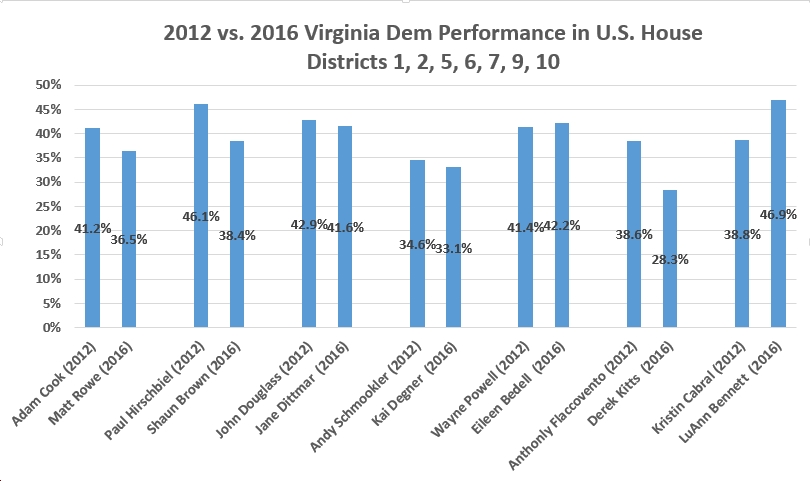In 2016, as is usually the case, most Virginia congressional districts were safely “gerrymandered for incumbent protection,” so they weren’t particularly competitive. For instance, the strongly “blue” 11th CD didn’t even see a Republican challenger to Rep. Gerry Connolly. And although the 3rd and 8th CDs had Republican challengers to Reps. Bobby Scott and Don Beyer, respectively, they of course had no chance and got wiped out at the polls.
In several deep-red districts, like the 6th, 7th and 9th CDs, Democrats did run candidates, but unfortunately all of them lost badly. In the 2nd CD, which is borderline competitive, Democrats were not able to recruit a top-tier candidate and, predictably, got annihilated. In the newly-drawn 4th CD (following the racial “unpacking” of the neighboring 3rd CD), Donald McEachin (R) won easily, as expected, against Sheriff Mike Wade (R). And in the 5th CD, which was borderline “purple,” Democrat Jane Dittmar lost badly to Republican Tom Garrett.
How did these results compare to 2012? See the chart below, although as you look at it, keep in mind that most of the districts changed a bit after the 3rd CD’s court-ordered “unpacking.” Still, a few things jump out at me here.
- LuAnn Bennett performed the best of any Democratic candidate in the 10th CD since 1980, when Frank Wolf first won the seat for the Republicans. And it wasn’t even close, with Bennett outperforming the 2014 Dem nominee, John Foust, by about 7 percentage points; the 2012 Dem nominee, Kristin Cabral, by about 9 percentage points; the 2010 Dem nominee, Jeff Barnett, by about 13 percentage points, etc. Clearly, the district is getting more “blue,” but also this was the most serious campaign the Democrats arguably have ever run in this district…at least in several decades.
- The 9th CD, for Democrats, is basically a killing field at this point. I mean, in 2012, Democratic nominee Anthony Flaccavento, received 38.6% of the vote, while this past Tuesday, Democratic nominee Derek Kitts only received 28.3% of the vote, a decline of 10.3 percentage points from an already-low share (both times against Rep. Morgan Griffith). This shows you what Democrats are up against in Appalachia these days…ugh.
- In the 7th CD, Democrat Eileen Bedell performed about 1 point better, running against Rep. Dave Brat (Far, than Wayne Powell in 2012 running against then Majority Leader Eric Cantor. So…not much change there, really.
- In the 6th CD, Democrat Kai Degner did about 1.5 percentage points worse in 2016 than our own Andy Schmookler did in 2012, both times against Rep. Bob BADlatte (aka, Goodlatte). Again, a sign of how Democrats are doing in rural, “red” America these days.
- In the 5th CD, which some prognosticators believed was competitive, Democrat Jane Dittmar ended up losing by nearly 17 points to Republican Tom Garrett in an open-seat race this past Tuesday. Nope, not competitive. In 2012, Democrat John Douglass lost by about 13 points to then-incumbent Rep. Robert Hurt. So…definitely getting worse for Dems in the 5th CD, which amazing was held by Tom Perriello as recently as 2010. Sigh.
- The 1st CD also was not a pretty picture for Democrats, with Democrat Matt Rowe only receiving 36.5% of the vote on Tuesday against Rep. Rob Wittman (R). This compares to 2012, when Democrat Adam Cook received 41.2% of the vote against Wittman — ergo, a nearly 5-percentage-point decline for Rowe compared to Cook.
It is important, of course, to compare the Congressional candidates to the performance of the “top of the ticket” (Clinton/Kaine) in their districts. As you can see from the statistics below, the Dem presidential ticket’s share of the vote fell in all the districts we’re looking at here, except for the 7th CD (where Clinton/Kaine outperformed Obama/Biden by 2.1 percentage points) and the 10th CD (where Clinton/Kaine outperformed Obama/Biden by 2.8 percentage points).
When you take that into consideration, LuAnn Bennett’s performance in the 10th CD is even more impressive (nice job!). In the 5th CD, Jane Dittmar’s decline from 2012 was about proportional to the top-of-the-ticket’s decline. Same thing in the 1st CD with Matt Rowe’s decline from 2012. In the 9th CD, Derek Kitts actually did several points worse than the 2016 vs. 2012 decline at the top of the ballot would have implied. Don’t ask me why, as Kitts’ profile seemed like an excellent fit for the 9th CD, and he did very well in the debate, from what I saw. Got me. In the 6th CD, Kai Degner did several points BETTER than the 2016 vs. 2012 decline at the top of the ballot would have implied. And in the 7th CD, Eileen Bedell did about 1 point worse than the 2016 vs. 2012 top-of-the-ticket numbers would have implied.
District 1: Obama got 45.5% in 2012; Clinton got 41.0% in 2016 — a 4.5 percentage point drop
District 2: Obama got 50.0% in 2012; Clinton got 45.0% in 2016 — a 5 percentage point drop
District 5: Obama got 45.8% in 2012; Clinton got 42.1% in 2016 — a 3.7 percentage point drop
District 6: Obama got 39.4% in 2012; Clinton got 34.3% in 2016 — a 5.1 percentage point drop
District 7: Obama got 41.6% in 2012; Clinton got 43.7% in 2016 — a 2.1 percentage point increase
District 9: Obama got 34.8% in 2012; Clinton got 27.2% in 2016 — a 7.6 percentage point drop
District 10: Obama got 48.7% in 2012; Clinton got 51.5% in 2016 — a 2.8 percentage point increase
Enough statistical wonkiness for one day? Hope you enjoyed it as much as I did! LOL















![Monday News: Trump’s Lunacy Pushes China, Russia, India, etc. Together; “Happy Labor Day. Donald Trump and Elon Musk Are Screwing Workers.”; “Where is the [media’s] intense focus on Trump’s failing health?”; ““Trump says he is not a dictator. Isn’t he?”](https://bluevirginia.us/wp-content/uploads/2025/09/montage0901-100x75.jpg)